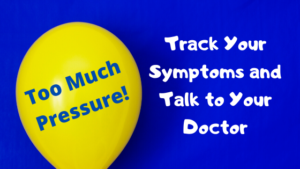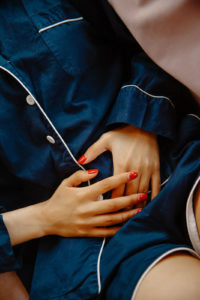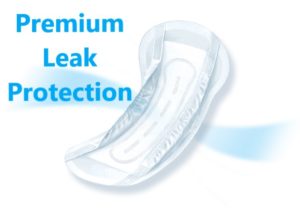Help! Why Do I Have Frequent Bladder Pain and Pressure?
Written by tyemedical on May 5th 2020
If you have ever had a urinary tract infection, then you know how uncomfortable and disruptive they can be. Now imagine experiencing that pain and pressure with a negative urine culture. No infection – just total bladder discomfort. An antibiotic won’t cure your symptoms. Now what?
 You can start by keeping a symptom journal that includes how much fluid you drink each day, along with how often you use the toilet. Record other important information, like where you’re at in your menstrual cycle, other health conditions that are flaring up, and any changes in your diet or activity levels. Note days that are especially troublesome and detail your symptoms.
You can start by keeping a symptom journal that includes how much fluid you drink each day, along with how often you use the toilet. Record other important information, like where you’re at in your menstrual cycle, other health conditions that are flaring up, and any changes in your diet or activity levels. Note days that are especially troublesome and detail your symptoms.
Then talk to your doctor about the information you have collected in your journal. She’ll likely refer you to a urologist, so be sure to follow up. Untreated symptoms can lead to additional problems like urinary incontinence or indicate an underlying condition that needs attention.
In the meantime, here’s some insight into possible culprits for your bladder pain and discomfort.
Not Emptying Your Bladder Completely
Doctors call this incomplete bladder emptying or chronic urinary retention (CUR). For any number of reasons, your bladder doesn’t completely empty when you use the toilet. Over the course of a day, this residual fluid builds up in your bladder as additional liquid is added. The expanding collection of urine in your bladder causes increased heaviness and pressure that can be extremely uncomfortable or even painful. But when you go to the bathroom, you still don’t evacuate all of it – and so the pressure builds again.
The problem is that you can’t exactly will yourself to empty your bladder. As far as you can tell, you’ve urinated all you can. An hour or two later, you find yourself in the bathroom again…and then again…you get the idea. Your bladder fills up quickly because it’s never even close to empty.
The frequency that often accompanies CUR is easily misdiagnosed as overactive bladder (OAB), but they’re two separate conditions. The most common cause of OAB is involuntary bladder contractions. Your doctor will most likely use an ultrasound to determine how much urine is left in your bladder after using the bathroom. This will help determine if your condition is more likely CUR or OAB.
Additionally, your urologist will want to rule out any obstructions or blockages that could be causing your symptoms (like an enlarged prostate in men or a prolapsed bladder in women). If everything checks out here, then they’ll likely prescribe a temporary medication to see if symptoms resolve.
Tips for Getting Relief
Meanwhile, here are some helpful tips for easing symptoms.
Double voiding
After urinating, wait at least thirty seconds, then lean forward, and try again to see if you can expel any additional fluid. You can also leave and come back in a couple minutes to see if you can finish emptying your bladder. But whatever you do, don’t strain, or try to force a flow, because this can affect your pelvic floor muscles.
Go when you need to
Urine was never meant to stay in your bladder indefinitely. So, when you feel the urge, it’s best to go, especially when you’re not emptying completely. The lingering fluid can irritate your bladder lining or even cause a bladder infection.
Learn to relax
When you’re tense or stressed, you tend to tighten your muscles, including your pelvic floor and bladder muscles. This can cause unnecessary, prolonged pressure on the bladder. Pay attention to your body and stress levels throughout the day, if you catch yourself tensing up, especially in the pelvic area, take a few deep breaths and try to relax. Maybe take a five-minute break or do some yoga or stretching if you can.
 Painful Bladder Syndrome
Painful Bladder Syndrome
This condition causes symptoms similar to chronic urinary retention but is primarily due to chronic inflammation in the bladder (not incomplete emptying). It’s also called interstitial cystitis (IC) and symptoms include pain, pressure, or discomfort in the bladder area. Discomfort ranges from mild pressure to severe pain that may be constant or occasional. It’s often accompanied by frequent trips to the bathroom or urgency.
The exact cause of painful bladder syndrome remains a mystery, which means it’s about symptom management. According to the Interstitial Cystitis Foundation, researchers believe damage to the bladder lining could trigger IC by allowing irritants found in urine to penetrate the bladder.
Some IC triggers include:
- Bladder trauma (i.e. during pelvic surgery)
- Long periods without bathroom access (less common)
- Autoimmune disorder (immune system attacking bladder)
- Problem with pelvic floor muscles (unable to tighten or relax)
- Bladder infection
- Spinal cord trauma
- Increased bladder histamines
- Chronic inflammation
Talk to your doctor about your symptoms, and she’ll rule out OAB and CUR before considering an IC diagnosis and offering treatment options. In the meantime, focus on your general health by eating a nutritious diet, practicing stress management, and getting adequate sleep.
Remember that with either condition, it’s important to follow up with your doctor and determine underlying causes to help slow progression.
 Are You Also Experiencing Bladder Leakage?
Are You Also Experiencing Bladder Leakage?
It’s not uncommon to experience bladder leaks along with the pain and pressure caused by incomplete bladder emptying and interstitial cystitis. Whether you’re dealing with smaller occasional leaks or battling more serious incontinence issues, we provide reliable, premium products to match your needs.
Our LivDry Ultra-Thin Pads offer discreet, comfortable protection for light leaks.
For maximum protection, try our LivDry Protective Underwear for a comfortable fit and a highly absorbent Super Absorbent Gel Core.

